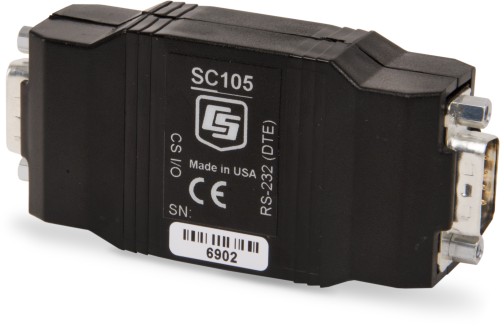






Overview
The SC105 is a CS I/O to RS-232 adapter used to connect a Campbell Scientific datalogger to an RS-232 DCE device. Common DCE devices used with the SC105 include cellular modems, radios, and smart serial sensors. The SC105 is compatible with any datalogger that has a CS I/O port. Multiple SC105 interfaces can be connected to a single datalogger CS I/O port.
Read More
Benefits and Features
- Supports communication between a data logger and an RS-232 DCE device
- Communicates at baud rates up to 115.2 kbps
- Provides internal buffering capability to ensure no data is lost during transmission
- Data logger can operate at a different baud rate than the DCE device
- No power source needed—powered by the datalogger and computer
- Compatible with most Campbell Scientific data loggers
- Helps protect components from electrical damage
- Ships with cables needed for most uses
Images

Detailed Description
The SC105 provides internal buffering that temporarily stores data. This buffering allows the data logger and DCE device to operate at different baud rates by storing the data received from the faster device until the slower device is ready to receive it. Internal buffering also ensures that no data is lost during transmission.
Compatibility
Please note: The following shows notable compatibility information. It is not a comprehensive list of all compatible products.
Dataloggers
| Product | Compatible | Note |
|---|---|---|
| 21X (retired) | The 21X does not support direct output to a printer; use an SC932 for this purpose. | |
| CR10 (retired) | ||
| CR1000 (retired) | ||
| CR10X (retired) | ||
| CR200X (retired) | ||
| CR211X (retired) | ||
| CR216X (retired) | ||
| CR23X (retired) | ||
| CR3000 (retired) | ||
| CR500 (retired) | ||
| CR5000 (retired) | ||
| CR510 (retired) | ||
| CR6 | ||
| CR800 (retired) | ||
| CR800 (retired) | ||
| CR850 (retired) | ||
| CR850 (retired) | ||
| CR9000 (retired) | ||
| CR9000X (retired) |
Additional Compatibility Information
Cable Connections and Mounts
Three cables (13657 Null Modem Cable, SC12 CS I/O Data Cable, and 10873 Serial Data Cable) are shipped with the SC105. The 13657 cable is used to program the device via a computer. The SC12 cable connects the SC105 to the data logger, and the 10873 cable connects the SC105 to the RS-232 DCE device. An SC12R-6 cable (purchased separately) may be used instead of the SC12 cable if a longer cable is required.
The 16987 mounting kit is available for attaching the SC105 to the backplate of an environmental enclosure.
Data Logger Considerations
Note: When using an SC105 with OS version 4 or newer with a mixed-array data logger, the data logger operating system should be updated to the latest released version.
Specifications
| Baud Rates Supported | 1200, 9600, 19200, 38400, 57600, 115200 bps |
| RS-232 Parity Supported | Even, odd, none |
| RS-232 Data Bits Supported | 7, 8 |
| CS I/O Port Modes | CSDC, SDC, ME, Addressed Print Device for P96 output |
| Power Requirements | Data logger’s 5 V supply |
| Current Drain |
|
| Operating Temperature Range |
|
| Operating Relative Humidity | up to 95% (non-condensing) |
| Dimensions | 2.3 x 4.3 x 9.2 cm (0.9 x 1.7 x 3.6 in.) |
| Weight | 45.4 g (1.6 oz) |
Documents
Brochures
Downloads
SC105 OS v.04 (573 KB) 28-08-2007
Current SC105 firmware. Requires the Device Configuration Utility and a 9-pin socket (female) to socket (female) NULL modem cable.
Device Configuration Utility v.2.33 (49.6 MB) 07-07-2025
A software utility used to download operating systems and set up Campbell Scientific hardware. Also will update PakBus Graph and the Network Planner if they have been installed previously by another Campbell Scientific software package.
Supported Operating Systems:
Windows 11 or 10 (Both 32 and 64 bit)
Frequently Asked Questions
Number of FAQs related to SC105: 6
Expand AllCollapse All
-
Depending on what equipment is being used, a special interface may be required to attach a specific device to the data logger’s CS I/O port. In general, devices with a CS I/O port can be attached directly to the data logger’s CS I/O port. Devices with an RS-232 port require a special interface, such as the SC932A or SC105, to connect to the data logger’s CS I/O port.
-
The SC105 uses the RS-232 standard, which is not compatible with multidrop communications (more than two devices on the same RS-232 bus). There are some third-party devices on the market that allow multiple devices to communicate over the same RS-232 link.
-
The SC105 needs to be connected to the data logger’s CS I/O port, either directly or with the included SC12 cable. The SC105’s RS-232 port needs to be connected to the PC’s serial port using the included null modem cable.
-
The SC932A only is compatible with modem-enabled (ME) two-way communication between a data logger and a modem. In contrast, the SC105 is compatible with both ME and Synchronous Device for Communication (SDC) communications, as well as having the ability to internally buffer data.
-
An RS-232 device cannot be directly connected to the CS I/O port of the data logger. A peripheral, such as an SC932A or SC105, is required.
-
Most third-party modems require a null modem cable, SC105, SC110 cable, or SC932A to interface with a data logger. Many modems manufactured by Campbell Scientific can connect directly to a data logger’s CS I/O port using an SC12 or serial cable.
Case Studies
Korea Expressway Corporation (KEC) was established in 1969 to construct and manage expressways throughout South......read more
Listed Under
Privacy Policy Update
We've updated our privacy policy. Learn More
